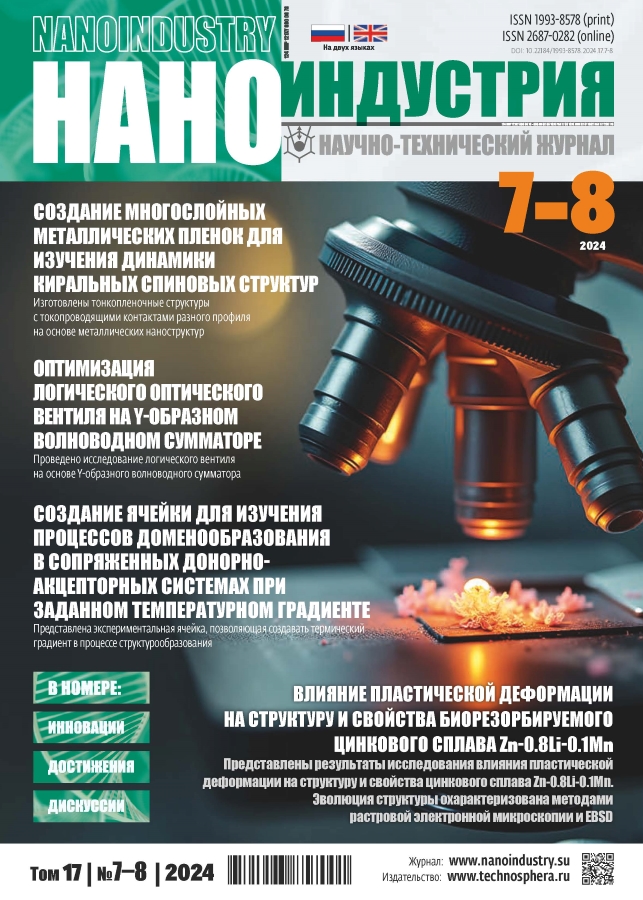Scanning capillary microscopy as a tool for nanocapillary printing
- Authors: Akhmetova A.I.1,2, Sovetnikov T.O.1,2, Terentev A.D.1,2, Yaminsky I.V.1,2
-
Affiliations:
- Lomonosov Moscow State University
- Advanced Technologies Center
- Issue: Vol 17, No 7-8 (2024)
- Pages: 418-425
- Section: Nanotechnologies
- URL: https://journals.eco-vector.com/1993-8578/article/view/642489
- DOI: https://doi.org/10.22184/1993-8578.2024.17.7-8.418.425
- ID: 642489
Cite item
Abstract
Controlled manipulation of cultured cells and local delivery of macromolecules and substances are still unsolved problems in experimental biology. Intracellular injection of various therapeutic agents, including biologics and supramolecular agents, is difficult due to natural biological barriers required to protect the cell. Efficient delivery of nucleic acids, proteins, peptides and nanoparticles is critical for clinical implementation of new technologies that can benefit the treatment of diseases using gene and cell therapy. Using a capillary, it is possible to locally apply a desired substance to a cell or even introduce it into the cell, and then evaluate its effect on morphology using scanning capillary microscopy (SCM) tools. These capabilities make the capillary microscopy method promising for biomedical purposes.
Full Text
About the authors
A. I. Akhmetova
Lomonosov Moscow State University; Advanced Technologies Center
Email: yaminsky@nanoscopy.ru
ORCID iD: 0000-0002-5115-8030
Cand. of Sci. (Physics and Mathematics), Researcher
Lomonosov Moscow State University, Physical Department
Russian Federation, Moscow; MoscowT. O. Sovetnikov
Lomonosov Moscow State University; Advanced Technologies Center
Email: yaminsky@nanoscopy.ru
ORCID iD: 0000-0001-6541-8932
Postgraduate, Engineer, Leading Engineer
Lomonosov Moscow State University, Physical Department
Russian Federation, Moscow; MoscowA. D. Terentev
Lomonosov Moscow State University; Advanced Technologies Center
Email: yaminsky@nanoscopy.ru
ORCID iD: 0009-0009-1528-5284
Postgraduate, Programmer
Lomonosov Moscow State University, Physical Department
Russian Federation, Moscow; MoscowI. V. Yaminsky
Lomonosov Moscow State University; Advanced Technologies Center
Author for correspondence.
Email: yaminsky@nanoscopy.ru
ORCID iD: 0000-0001-8731-3947
Doct. of Sci. (Physics and Mathematics), Prof., Director General
Lomonosov Moscow State University, Physical Department
Russian Federation, Moscow; MoscowReferences
- Elnathan R. et al. Engineering vertically aligned semiconductor nanowire arrays for applications in the life sciences. Nano Today 9. 2014. PP. 172–196. https://doi.org/10.1016/j.nantod.2014.04.001
- Tay A. The benefits of going small: nanostructures for mammalian cell transfection. ACS Nano. 2020. Vol. 14. PP. 7714–7721. https://doi.org/10.1021/acsnano.0c04624
- He G. et al. Nanoneedle platforms: the many ways to pierce the cell membrane. Adv. Funct. Mater. 2020. Vol. 30. P. 1909890. https://doi.org/10.1002/adfm.201909890
- Liu R. et al. High density individually addressable nanowire arrays record intracellular activity from primary rodent and human stem cell derived neurons. Nano Lett. 2017. Vol. 17. PP. 2757–2764. https://doi.org/10.1021/acs.nanolett.6b04752
- Abbott J. et al. Optimizing nanoelectrode arrays for scalable intracellular electrophysiology. Acc. Chem. Res. 51. 2018. PP. 600–608. https://doi.org/10.1021/acs.accounts.7b00519
- Chen Y. et al. Emerging roles of 1D vertical nanostructures in orchestrating immune cell functions. Adv. Mater. 32. 2020. P. e2001668. https://doi.org/10.1002/adma.202001668
- Wang Z. et al. Interrogation of cellular innate immunity by diamond-nanoneedle-assisted intracellular molecular fishing. Nano Lett. 2015. Vol. 15. PP. 7058–7063. https://doi.org/10.1021/acs.nanolett.5b03126
- Leitao S.M. et al. Spatially multiplexed single-molecule translocations through a nanopore at controlled speeds. Nat. Nanotechnol. 2023. Vol. 18. PP. 1078–1084. https://doi.org/10.1038/s41565-023-01412-4
- Varongchayakul N. et al. Single-molecule protein sensing in a nanopore: a tutorial. Chem. Soc. Rev. 47. 2018. PP. 8512–8524. https://doi.org/10.1039/c8cs00106e
- Chau C.C. et al. Macromolecular crowding enhances the detection of DNA and proteins by a solid-state nanopore. Nano Lett. 20. 2020. PP. 5553–5561. https://doi.org/10.1021/acs.nanolett.0c02246
- Confederat S. et al. Next-generation nanopore sensors based on conductive pulse sensing for enhanced detection of nanoparticles. Small. 2023. https://doi.org/10.1002/smll.202305186
- Chau C.C. et al. Single molecule delivery into living cells. Nat Commun. 2024. Vol. 15. No. 1. P. 4403. https://doi.org/10.1038/s41467-024-48608-3
- O’Connell M.A. et al. Positionable vertical microfluidic cell based on electromigration in a theta pipet. Langmuir. 2014. Vol. 30. PP. 10011–10018. https://doi.org/10.1021/la5020412
- McKelvey K. et al. Meniscus confined fabrication of multidimensional conducting polymer nanostructures with scanning electrochemical cell microscopy (SECCM). Chem. Comm. 2013. Vol. 49. PP. 2986–2988. https://doi.org/10.1039/c3cc00104k
- Pastre D. et al. Characterization of AC mode scanning ion-conductance microscopy. Ultramicroscopy. 2001. Vol. 90. PP. 13–19. https://doi.org/10.1016/s0304-3991(01)00096-1
- Rheinlander J., Schaffer T.E. An accurate model for the ion current–distance behavior in scanning ion conductance microscopy allows for calibration of pipet tip geometry and tip–sample distance. Anal. Chem. 2017. Vol. 89. No. 21. PP. 11875–11880. https://doi.org/10.1021/acs.analchem.7b03871
- Lukashenko S.Y. et al. Behavioral features of the approach curve of a scanning ion-conductance microscope. J. Surf. Investig. 2023. Vol. 17. PP. 585–591. https://doi.org/10.1134/S1027451023030096
- Sovetnikov T.O. et al. Characteristics of the use of scanning capillary microscopy in biomedical research. Bio-Medical Engineering 57. 2023. Vol. 4. PP. 250–253. https://doi.org/10.1007/s10527-023-10309-4
- Rodolfa K.T. et al. Two-Component Graded Deposition of Biomolecules with a Double-Barreled Nanopipette. Angewandte Chemie International Edition. 2005. Vol. 44. No. 42. PP. 6854–6859. https://doi.org/10.1002/anie.200502338
- Akhmetova A.I. et al. Scanning capillary microscopy for biological applications. NANOINDUSTRY. 2024. Vol. 17. No. 6. https://doi.org/10.22184/1993-8578.2024.17.6.364.370
Supplementary files








